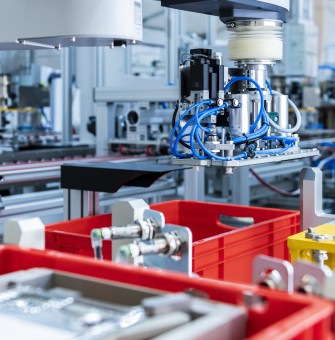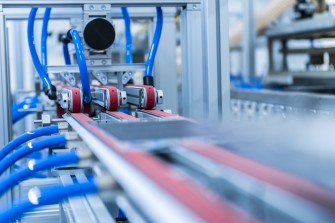Fuel Cell Solutions
Quantity scenarios from prototype production to series
Quantity scenarios from prototype production to series

Bipolar plates and MEAs are assembled and delivered to the line.
For prototype and small series assembly, we offer our customers scalable and individually tailored solutions. Product understanding and variant competence are our top priority. The selection of the required test processes and technology is part of our DNA
We enable you to enter into large series production with clocked 1 Hz cell stack technology for at least 50,000 fuel cell stacks per year. The next step is flow production, as the key to producing significantly larger quantities.
Manufacturing of metallic bipolar plates
Our solutions for fuel cell assembly
Our solutions for fuel cell assembly

Gripping system for bipolar plates within one of our systems for series production.
Our production systems for fuel cells are based on both clocked and flow processes. In order to enable the provision of materials, partial productions of the individual components become assembly processes. Bipolar plates, both stainless steel and graphene based, and MEAs (membrane electrode assemblies) are first assembled and then delivered to the line. The CCM (Catalyst-Coated-Membrane), the GDL (Gas-Diffusion-Layer) and the Sub-Gasket as components of the MEA are processed, aligned and assembled e.g. as roll material.
Our production systems for fuel cell stacks are based on clocked processes. In order to enable the provision of materials, partial productions of the individual components become assembly processes. Bipolar plates, both stainless steel and graphene based, and MEAs (membrane electrode assemblies) are first assembled and then delivered to the line. The CCM (Catalyst-Coated-Membrane), the GDL (Gas-Diffusion-Layer) and the Sub-Gasket as components of the MEA are processed, aligned and assembled e.g. as roll material.
The entire value chain - fast, flexible, in series
Electric drives with fuel cells as energy suppliers will play a major role in the emission-free vehicles of the future. The advantages are long ranges and short refuelling times, similar to combustion engines. When it comes to making freight and passenger transport as well as shipping more eco-friendly, the fuel cell is superior to a battery in terms of availability of raw materials, weight and size. We can provide you with the right production system for your requirements in terms of component variance, variable or fixed production quantities. With our assembly and test solutions for fuel cells, you can safely process more than 10,000,000 cells per year. Based on our experience from projects realized worldwide, we will find the right solution for you.
Test and conditioning
Test and conditioning

Safe transport of the sensitive MEA.
A defective part in the stack can lead to a total failure of the system in the vehicle. Our test benches and in-process test concepts monitor the quality of production and ensure the performance of the fuel cell stacks.
The current conditioning times of the stacks of up to 12 hours require extensive technical equipment in the manufacturing process. Together with partners we are working on a solution to reduce the conditioning times to 2 hours.
/thyssenkrupp_logo_claim_d.svg)







